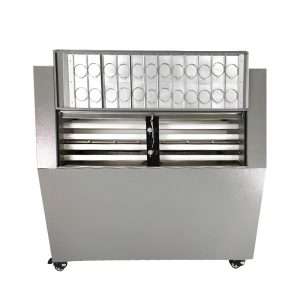Penerapan kotak penuaan UV pada interior otomotif
The purpose of UV aging tests is to evaluate the weather resistance of automotive interior materials and determine their service life and performance under long-term UV irradiation and climatic conditions. Uv irradiation has the following effects on automotive interior materials:
Fading: UV irradiation can cause the color of automotive interior material surfaces to fade or fade.
Decreased durability: UV irradiation can reduce the durability of automotive interior materials, making them brittle, retak, or losing elasticity.
Deformasi: Long-term UV irradiation can cause deformation of automotive interior materials, such as deformation, warping or distortion of plastic materials.
Penerapan kotak penuaan UV pada interior otomotif
Reduced wear resistance: UV irradiation can lead to a reduction in the surface hardness of automotive interior materials, thus affecting their wear resistance.

Standard of reference
The industry standards for UV aging test of automotive interior materials mainly include the following:
ISO 4892-2: This standard specifies methods and procedures for UV radiation aging tests of plastic materials under laboratory conditions and is suitable for evaluating the weather resistance of automotive interior materials.
SAE J2412: This is a standard developed by the Society of Automotive Engineers that specifies the methods and requirements for UV irradiation aging testing of automotive interior materials.
Penerapan kotak penuaan UV pada interior otomotif
Kasus aplikasi tertentu
The specific application of UV aging test box in automotive interior is as follows:
Seat materials: For materials such as fabric, leather and faux leather of car seats, UV aging tests can evaluate their color stability and durability.
Instrument panels: Automotive instrument panels are often exposed to sunlight, and UV aging tests can evaluate their resistance to fading, crack and deformation.
Interior panels: For plastic interior panels and trim pieces, UV aging tests can evaluate their color stability, daya tahan, and surface quality changes.
The application of UV aging box in automotive interior is illustrated in Figure 2
Penerapan kotak penuaan UV pada interior otomotif
Metode tes
Using UV aging test chamber to test the aging resistance of automotive interior materials, umumnya dapat dilakukan sesuai dengan langkah-langkah berikut:
Prepare samples: according to the characteristics and dimensions of actual automotive interior materials, prepare samples that meet the requirements.
Tetapkan kondisi pengujian: sesuai dengan persyaratan pengujian atau standar yang berlaku, mengatur intensitas radiasi UV, suhu, kelembaban dan kondisi pengujian lainnya.
Penempatan sampel: Place the sample of automotive interior materials on the sample table in the UV aging test chamber to ensure that the sample is exposed to the light source of UV radiation.
Penerapan kotak penuaan UV pada interior otomotif
Jalankan tes: Biarkan sampel terkena radiasi UV dan kondisi pengujian lainnya secara terus menerus selama jangka waktu tertentu sesuai dengan kondisi pengujian yang ditetapkan.
Observasi dan evaluasi: Amati dan evaluasi perubahan sampel secara teratur, termasuk perubahan warna, kondisi permukaan, physical properties changes, dll., dan mencatat serta mencatat data yang relevan.
Analisis hasil: The aging resistance and expected life of automotive interior materials were evaluated based on the sample changes and performance losses observed during the test.
* Test procedures and parameter Settings should be adjusted and confirmed according to test standards, characteristics of automotive interior materials and actual needs. It is recommended to refer to applicable standards and relevant equipment instructions before performing UV aging tests to ensure the accuracy and reliability of the tests.
